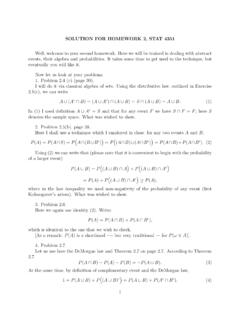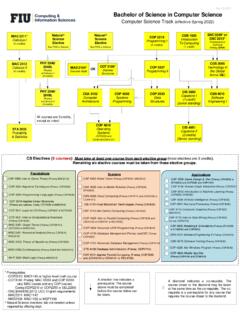Transcription of Introduction to Operations Management
1 ~metin1 Introduction toOperations ManagementChapter 1 These slides are based in part on slides that come with Cachon& Terwieschbook Matching Supply with Demand If you want to use these in your course, you may have to adopt the book as a textbook or obtain permission from the authors Cachon& Terwiesch. ~metin2 Learning Objectives Operations Management Introduction . Manufacturing and Service Operations . How can Operations Management help? ~metin3OM = Operations Management Management of ANY activities/process that create goods and provide services Exemplary Activities: Forecasting Scheduling, Quality managementProfit 10%OM Cost 20%Marketing Cost 25%Manufacturing Cost 45% Why to study OM Cost and profit breakdown at a typical manufacturing company How to make more profit?
2 Cost cutting. Which costs affect the revenue? Management of Operations is critical to create and maintain competitive ~metin4 Operations Management Operations Management : The Management of the efficient transformation of inputs into outputs to effectively satisfy customers. The active role of Operations : Inputsbecome Outputsafter some Transformation(Process or Operation) Food processing example:InputsTransformationOutputsEnerg y, Raw vegetablesCleaningClean vegetablesEnergy, Metal sheetsCutting/Rolling/WeldingCansEnergy, VegetablesCutting/ChoppingCut vegetablesEnergy, Water, VegetablesCookingBoiled vegetablesEnergy, Cans, Boiled vegetablesPlacingCan ~metin5 Operations in services.
3 Health careInputsProcessesOutputsDoctors, nursesExaminationHealthy patientsHospitalSurgeryMedical SuppliesMonitoringEquipmentMedicationLab oratoriesTherapySOM offers medical Management MBA and Master of ScienceSee Question: What are Inputs, Processes and Outputs in education?Who is the customer? ~metin6 Operations are everywhere !OperationsExamplesGoods producingFarming, mining, constructionStorage/transportationWareho using, trucking, mail, taxis, buses, hotelsExchangeTrade, retailing, wholesaling, renting, leasing, loansEntertainmentRadio, movies, TV, concerts, recordingCommunicationNewspapers, journals, radio, TV, telephones, ~metin7OM at the core of Businesses Three basic functions Operations /Production Goods oriented (manufacturing and assembly) Service oriented (health care, transportation and retailing) Value-added (the essence of the Operations functions)
4 Finance-Accounting Budgets (plan financial requirements), Provision of funds Marketing Selling, Promoting, Assessing customer wants and ~metin8 Systems (Holistic) Approach Emphasize interrelations among subsystems. A systems approach is essential whenever something is being designed, redesigned, implemented, or improved. It is important to take into account the impact on all parts of the system. Example: A new feature is added to a product. Designer must take into account how customers will view the change, instructions for using new feature, the cost, training of workers, production schedule, quality standard, advertising must be informed about the new feature.
5 A new feature: Suitcase wheels The whole is greater than the sum of the parts. ~metin9 Who has the D(ecision)? Global vs. Local decision makers How much authority local businesses should have to tailor products to the local tastes / market conditions? Center vs. Business unit Should a parent company have a say in a subsidiary s capital investment? Function vs. Function Does product development or marketing decide on the standard features of a car? Inside vs. Outside partners Should the apparel manufacturers supervise hiring practices and monitor working conditions at their foreign suppliers?
6 Based on Who has the D? By Rogers and Blenko. HBR January ~metin10 Degree of Standardization ! Standardized output Take advantage of standardized methods, less skilled workers, standard materials. Example: Iron, Wheat, most of commodities Customized output Each job is different Workers must be skilled Example: Hair cut, outputs of most service ~metin11 Manufacturing vs. Service Operations Production of goods Tangible products Automobiles, Refrigerators, Aircrafts, Coats, Books, Sodas Services Repairs, Improvements, Transportation, Regulation Regulatory bodies: Government, Judicial system, FAA, FDA Entertainment services: Theaters, Sport activities Exchange services: Wholesale/retail Appraisal services: Valuation, House appraisal Security services: Police force, Army Education: Universities, K-12 schools Financial services: Retail banks, Rating agencies, Investment ~metin12 Manufacturing vs.
7 Service Operations Differences with respect of content of of of and of ~metin13 Manufacturing vs. ServicesCharacteristicManufacturingServi ceOutputTangibleIntangibleCustomer contactLowHighUniformity of outputHighLowLabor contentLowHighUniformity of inputHighLowMeasurement of productivityEasyDifficultOpportunity to correct quality problemsEasyDifficultSteel productionAutomobile fabricationHome remodelingRetail salesAuto RepairAppliance repairMaid ServiceManual car washTeachingLawn mowingHigh percentage goodsLow percentage ~ Manufacturing vs.
8 Service vs. Service Industries in the ~metin15 Responsibilities of Operations Management Planning Capacity, utilization Location Choosing products or services Make or buy Layout Projects Scheduling Market share Plan for risk reduction, plan B? ForecastingSUPPLY SIDEDEMAND SIDE Controlling Inventory Quality Costs Organization Degree of standardization Subcontracting Process selection Staffing Hiring/lay off Use of overtime Incentive plansIn a nutshell, the challenge is Matching the Supply with Demand ~metin16 Supply Does Not Naturally Match Demand Inventory results from a mismatch between supply and demand Mismatch can take one of the following two forms Supplywaits for Demand Inventory = Finished goods and resources Demandwaits for Supply Inventory is negative or said to be backordered in manufacturing Inventory = Waiting customers in services Mismatch happens because the demand varies the capacity is rigid and finite.
9 If the capacity is infinite, products (or services) can be provided at an infinite rate and instantaneously as the demand happens. Then there is no ~metin17 Air travelEmergency roomRetailingIron ore plantPacemakersSupplySeats on specific flightMedical serviceConsumer electronicsIron oreMedical equipmentDemandTravel for specific time and destinationUrgent need for medical serviceConsumers buying anew video system Steel millsHeart surgeon requires pacemaker at exact time and locationSupply exceeds demandEmpty seatDoctors, nurses, and infrastructure are under-utilizedHigh inventory costs.
10 Few inventory turnsPrices fallPacemaker sits in inventoryDemand exceeds supplyOverbooking; customer has to take different flight (profit loss)Crowding and delays in the ER, potential diversion of ambulancesForegone profit opportunity; consumer dissatisfactionPrices riseForegone profit (typically not associated with medical risk)Actions to match supply and demandDynamic pricing; booking policiesStaffing to predicted demand; prioritiesForecasting; quick response If prices fall too low, production facility is shut downDistribution system holding pacemakers at various locationsManagerial importanceAbout 30% of all seats fly empty; a 1-2% increase in seat utilization makes difference between profits and lossesDelays in treatment or transfer have been linked to death.













